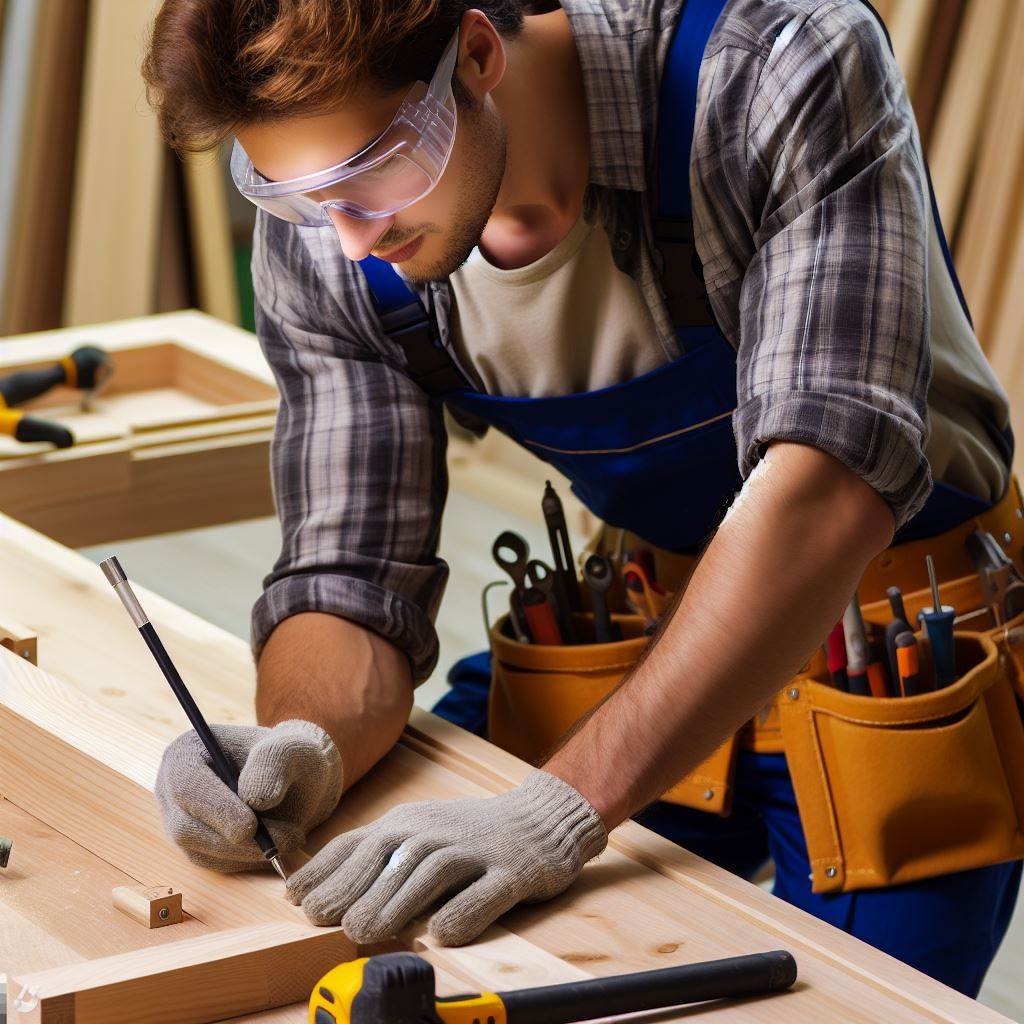Introduction
Joinery is a skilled profession in the UK that involves working with wood to create structures and furniture.
While joinery can be a rewarding career, it is essential for UK joiners to prioritize safety to prevent accidents and injuries.
The importance of safety in the joinery profession cannot be overstated. Joiners work with sharp tools and heavy machinery, which can pose significant risks if not handled properly.
By following essential safety tips, joiners can protect themselves and their colleagues from harm on the job.
Safety should be the top priority for UK joiners. They should always wear personal protective equipment (PPE) such as safety goggles, gloves, and steel-toed boots to protect themselves from potential hazards.
Additionally, it is crucial to maintain a clean and organized workspace to prevent slips, trips, and falls.
Proper training is vital for UK joiners to ensure they have the necessary skills and knowledge to carry out their work safely.
Joiners should receive comprehensive training on using tools and machinery, as well as understanding safety protocols and procedures.
Regular equipment maintenance is crucial to prevent accidents. Joiners must regularly inspect their tools and machinery for any signs of wear or damage.
Faulty equipment should be immediately repaired or replaced to minimize risks. Communication and teamwork are vital for a safe working environment.
Joiners should always communicate with their colleagues and supervisors about potential hazards or concerns.
By working together, they can identify and address safety issues before they lead to accidents. In general, safety is of utmost importance for UK joiners.
By following essential safety tips, wearing proper PPE, receiving adequate training, maintaining equipment, and promoting open communication, joiners can ensure a safe and productive work environment.
General safety measures
Joiners in the UK ensure workplace safety by adhering to specific measures, minimizing accidents and injuries.
Prioritize wearing proper PPE, including safety glasses, ear protection, and gloves for hazard protection.
Personalized UK Career Consulting
Receive tailored career guidance designed just for you. Get actionable steps and expert support to boost your career in 1-3 days. Take control of your career now.
Get StartedJoiners need awareness of essential PPE items like safety glasses, ear protection, and gloves to ensure safety.
Focus on minimizing respiratory risks, addressing dust inhalation through the use of dust extraction systems in joinery work.
Dust extraction systems, integrated into tools like sanders and saws, reduce airborne particles, requiring regular maintenance for effectiveness.
Well-informed tool and equipment usage is crucial; joiners should follow manufacturer instructions and conduct regular inspections for wear or damage.
Maintaining a clean, organized workspace is essential for safety, reducing the risk of tripping or falling accidents.
Effective communication and teamwork, facilitated by comprehensive training and clear instructions, promote safety among joiners.
In essence, emphasizing proper PPE, awareness of essential items, dust extraction, informed tool usage, a clean workspace, and effective communication ensure joiner safety.
Read: Joinery Tools: UK Professionals’ Top Picks
Safe handling of tools
Guidelines for safely handling hand tools
- Always wear appropriate personal protective equipment, such as gloves and safety goggles.
- Use the right tool for the job and ensure it is in good condition with no defects.
- Hold the tool firmly with a secure grip and keep your fingers away from cutting edges.
- Maintain a clean and organized work area to avoid tripping over tools or causing accidents.
- Keep the handles of tools clean and dry to prevent slipping while using them.
- Never carry sharp tools in your pockets and always use a toolbox or tool belt for storage.
Importance of keeping tools sharp and well-maintained
- Sharpened tools are more effective and require less force, reducing the risk of slips and accidents.
- Dull tools can cause materials to splinter or kick back, leading to injuries.
- Regularly inspect tools for wear and tear and repair or replace them as needed.
- Clean tools after use to prevent rust and maintain their performance.
- Properly maintained tools last longer, saving you money in the long run.
Potential hazards of power tools and recommended safety precautions
- Electrical shock: Ensure power tools are properly grounded or use a residual current device (RCD).
- Eye injuries: Wear safety goggles or a face shield to protect against flying debris.
- Hearing damage: Use ear defenders or earplugs when working with noisy power tools.
- Respiratory hazards: When using tools that generate dust or fumes, wear a mask to avoid inhalation.
- Hand injuries: Keep fingers away from moving parts and use clamps or vice grips when necessary.
- Follow manufacturer’s instructions for safe usage and regularly inspect power cords for damage.
Additional safety tips for joiners
- Wear appropriate clothing, including long-sleeved shirts and durable trousers to protect against cuts and abrasions.
- Use proper lifting techniques when carrying heavy materials to prevent strains or injuries.
- Ensure adequate lighting in your work area to avoid accidents caused by poor visibility.
- Stay focused and avoid distractions while operating tools, especially power tools.
- If you are unsure about a specific tool or task, seek guidance or training from a supervisor or experienced colleague.
- Regularly update your knowledge of safety regulations and best practices to stay informed and protected.
Remember, safety should always be a top priority in the workshop. By following these guidelines and being cautious, you can reduce the risk of accidents and create a safe working environment for yourself and others.
Read: Eco-Friendly Practices in UK Joinery Today
Working at Height Safety
Safety Measures when Working with Ladders and Scaffolding
- Always inspect the ladder or scaffolding for any damage or defects before use.
- Use the right type and size of ladder for the job, ensuring it’s properly rated for the weight.
- Set up the ladder or scaffold on stable ground or use a leveling device to ensure stability.
- Extend the ladder or scaffold at least three feet above the working area to provide a safe handhold.
- Use the “three-point contact” rule when climbing, maintaining two hands and one foot or two feet and one hand on the ladder at all times.
- Avoid overreaching while on the ladder or scaffold; reposition it instead.
- Securely brace the ladder or scaffolding to prevent any movement during use.
The Importance of Ensuring Stable Footing and Proper Ladder Placement
- Clear the work area of any debris, obstacles, or slippery surfaces that could cause instability.
- Check the stability of the ground before setting up the ladder or scaffold.
- When using a ladder, ensure the ladder shoes are in good condition and capable of providing adequate grip.
- Avoid using ladders in high winds or adverse weather conditions that may affect stability.
- Always place the ladder at the correct angle: for every four feet of height, the ladder should be one foot away from the wall or vertical surface.
Tips for Securing Tools and Materials to Prevent Accidents at Height
- Use tool belts or harnesses to keep tools secure and within reach while working at height.
- Avoid carrying excessive materials or tools up a ladder; use a hoist or pulley system instead.
- Securely fasten materials or equipment to the scaffold to prevent them from falling.
- Communicate with your coworkers to ensure no tools or materials are left loose at height.
- Regularly inspect and maintain the integrity of safety nets or guardrails installed on scaffolding.
Working at height can pose significant risks if proper safety precautions are not followed.
By implementing these safety measures, joiners can ensure a secure work environment and reduce the risk of accidents or injuries. Remember to always prioritize safety during every aspect of your work.
Read: UK Joiners’ Salary Guide: Expectations vs. Reality

Preventing Accidents and Injuries
1. Maintaining a Tidy and Clutter-Free Workspace
- A tidy and clutter-free workspace is essential for the safety of UK joiners.
- Remove any unnecessary tools, equipment, or materials from your work area.
- Keep walkways and access points clear of obstacles to prevent trips and falls.
- Store tools and materials properly after use to prevent accidents and injuries.
- Regularly inspect and clean your workspace to ensure a safe and organized environment.
- Encourage your colleagues to adopt the same tidiness standards for a safer workplace.
2. Proper Lifting Techniques to Prevent Strains and Injuries
- Using proper lifting techniques is crucial to avoid strains and injuries as a UK joiner.
- When lifting heavy objects, always bend your knees and use your leg muscles.
- Keep the object close to your body and maintain a strong grip to have better control.
- Avoid twisting your body while lifting; instead, use your feet to pivot if needed.
- If an object is too heavy or awkward to lift on your own, ask for assistance.
- Use mechanical lifting aids or equipment for particularly heavy or bulky items.
3. Regular Breaks and Stretches to Avoid Fatigue
- Taking regular breaks and stretching is vital to prevent fatigue-related accidents and injuries.
- Fatigue can impair your concentration, reaction time, and overall alertness.
- Schedule short breaks throughout the day to rest, hydrate, and refuel your body.
- During breaks, engage in simple stretching exercises to relieve muscle tension.
- Avoid working excessively long hours without breaks, as it increases the risk of accidents.
- Encourage your colleagues to prioritize their well-being by taking breaks and stretching regularly.
UK joiners minimize accidents by maintaining tidy workspaces, removing unnecessary tools, ensuring clear walkways, and proper storage. Prioritize safety through regular inspections and cleanings.
Your Dream Job Starts with a Perfect CV
Get a tailored CV and cover letter that captures your unique strengths and stands out in your industry. Let us help you make an unforgettable first impression.
Get StartedUse proper lifting techniques to prevent strains; bend knees, use leg muscles, keep objects close, and avoid twisting.
Regular breaks and stretches are crucial for preventing fatigue-related accidents; schedule short breaks, hydrate, and engage in stretching exercises.
Generally, UK joiners ensure safety by maintaining tidy workspaces, using proper lifting techniques, and taking regular breaks.
Read: Top UK Joinery Schools & Training Programs
Chemical and material safety
- Reading and understanding safety data sheets for chemicals is of utmost importance.
- Safe storage and handling of flammable substances, adhesives, and finishes is crucial.
- Proper ventilation and respiratory protection are necessary when working with hazardous substances.
Joiners in the UK prioritize safety by understanding chemical hazards, safe storage, and proper ventilation when working with materials.
Reading safety data sheets informs joiners about hazards, proper handling, storage, disposal, and emergency response for chemicals.
Safe storage of flammable substances is crucial; joiners must label and use safety containers, wearing appropriate PPE when handling.
Proper ventilation is vital; joiners use respiratory protection when working with hazardous substances like paints, varnishes, and adhesives.
In review, joiners prioritize chemical and material safety by informed decision-making, safe storage practices, and respiratory protection for a secure working environment.
Emergency procedures
Accidents can happen unexpectedly, and it is crucial for joiners to be prepared and informed about emergency procedures that need to be followed.
Knowing how to handle common accidents such as cuts or falls can make a significant difference in ensuring the safety of everyone involved. Here are some essential safety tips to consider:
- Basic first aid knowledge: It is highly advisable for joiners to undergo basic first aid training. This training equips them with the necessary skills to handle accidents and injuries effectively.
- Knowing the location of first aid kits: In case of accidents, joiners should be aware of the precise location of first aid kits within their workplace. These kits contain essential supplies that can help address injuries promptly.
- Knowing the location of fire extinguishers: Fire accidents can pose significant risks to joiners and the entire workplace. It is crucial to know the whereabouts of fire extinguishers and familiarize oneself with their operation.
- Understanding the steps to take during accidents: Joiners should be familiar with the necessary steps to follow in case accidents occur. This includes actions like stopping bleeding by applying pressure and seeking medical attention promptly.
- Calling for help: During emergencies, it is crucial to seek assistance immediately. Joiners should know the emergency contact numbers and be prepared to provide clear information about the situation.
- Reporting accidents and incidents: It is necessary to report accidents and incidents, regardless of their severity. This enables proper documentation and investigations to identify the root causes and prevent future occurrences.
Being proactive and prepared is the key to ensuring safety in the joinery profession.
By implementing these safety tips and familiarizing themselves with emergency procedures, joiners can minimize risks and create a safer working environment. Remember, prevention is always better than cure.
Conclusion
The safety tips discussed in this section are crucial for UK joiners to follow. By implementing these measures consistently, joiners can ensure their well-being and the well-being of their colleagues on the job.
Optimize Your LinkedIn for Success
Boost your LinkedIn profile with a professional bio, keyword-rich headline, and strategic recommendations that attract recruiters. Stand out from the crowd and get noticed.
Optimize NowIt is essential to prioritize safety in the joinery profession and understand the vital role it plays.
Remember to always wear personal protective equipment, be cautious of hazardous materials, and maintain a clean and organized workspace.
Additionally, make use of appropriate tools and equipment, and regularly inspect and maintain them. Adequate training, communication, and teamwork are also essential for a safe working environment.
By keeping these safety tips in mind, joiners can prevent accidents and injuries and complete their work with efficiency and professionalism.
Always prioritize your well-being and the well-being of others on the job. Stay safe!
[E-Book for Sale]
500 Cutting-Edge Tech Startup Ideas for 2024 & 2025: Innovate, Create, Dominate
$19.99 • 500 Tech Startup Ideas • 62 pages
You will get inspired with 500 innovative tech startup ideas for 2024 and 2025, complete with concise descriptions to help you kickstart your entrepreneurial journey in AI, Blockchain, IoT, Fintech, and AR/VR.




